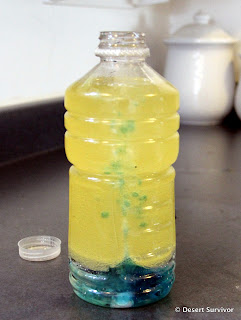It's time for another science experiment! We're going to make our very own Lava Lamp!
This project requires four things:
* an empty, clean bottle
* vegetable oil
* food coloring
* Alka-Seltzer tablet
Next step: fill nearly to the top with water. Watch where the water goes.
Note--have the child that spills more pour in the water. It makes cleanup a lot easier.
Even though the water was poured on top of the oil, it ends up at the bottom. Why?
(Water is denser than oil, so it sinks.)
Ask your child to try to mix the water and oil by shaking the bottle.
When they don't mix, tell your child to shake harder.Eventually you should explain why they won't mix. (Basically the water molecules form an exclusive clique, not allowing any other non-polar molecules to join them. Oil is non-polar, so it can't join the party. Check out a more detailed explanation here.)
Of course, if your kids have lots of energy, you could have them shake the bottle for a very long time.
They may, however, really want to get to the next step:
Adding the food coloring! (A great use for a food additive that's not so good to put into our bodies.)
The instructions said to put in 10 drops, but we put in a lot more than that. Where does the dye go?
Finally came the last part: put in a piece of an Alka-Seltzer tablet.
It takes over 20 seconds for something noticeable to happen after the Alka-Seltzer is dropped in.
But then it becomes quite apparent; something magical is happening. Blue bubbles are rising.
They become more and more agitated. Once they reach the surface, the blue sinks back down to the bottom. The Alka-Seltzer creates carbon dioxide gas, which clings to the molecules of water, which have been colored. The gas is less dense than the water or oil, so it rises to the surface, attached to the colored water. Once the carbon dioxide reaches the surface, the gas is released, and the colored water molecule sinks back to the bottom.

The kids found this fascinating.
They took turns putting in the other pieces of the Alka Seltzer tablet.
We did this experiment many times. Actually, it's a demonstration, as we're watching it over and over. To really be an experiment, we need to be able to change things: amount of Alka-Seltzer, or have several bottles with different amounts or types of oil. Nevertheless, I think they learned at least a couple scientific things during this lava lamp demonstration.
Later we did it in the evening and used a flashlight to illuminate the lava lamp, and it looked so cool.
This was a really fun project, and we still have it on the shelf to share with visitors. The lava lamp has made a trip to school, and I think it will be around for awhile.




































1 comment:
How fun! Ava liked looking at that with me :)
Post a Comment